This was published 4 years ago
Moscow to St Petersburg cruise: How Russia has changed after 35 years
By Sue Williams
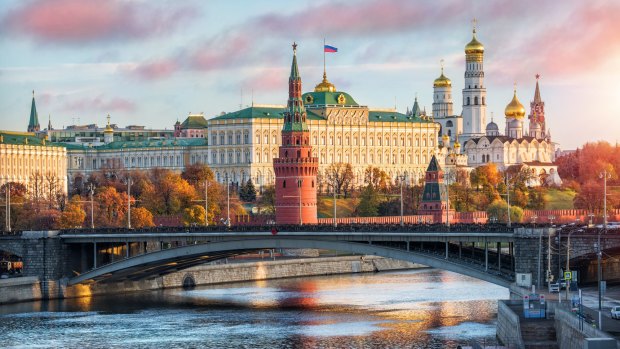
The Kremlin in Moscow.Credit: iStock
A former communist country now ruled by one of the world's most flamboyant leaders who's believed to be the richest man on earth?
Our Russian guide rolls his eyes. "We Russians like strong leaders," he shrugs. "Look at our history. We've had Ivan the Terrible, Peter the Great, Catherine the Great, Stalin … And now we have Vladimir Putin, God bless his soul. We look forward to our grandchildren voting for him, and their grandchildren. And if you detect a note of sarcasm in my voice, then I'm afraid you are very much mistaken."
Russia has always been a fascinating place to visit, and never more so than now: the 30th anniversary of the fall of the Berlin Wall, the end of the Cold War and the start of perestroika that would two years later lead to the dissolution of the Soviet Union.
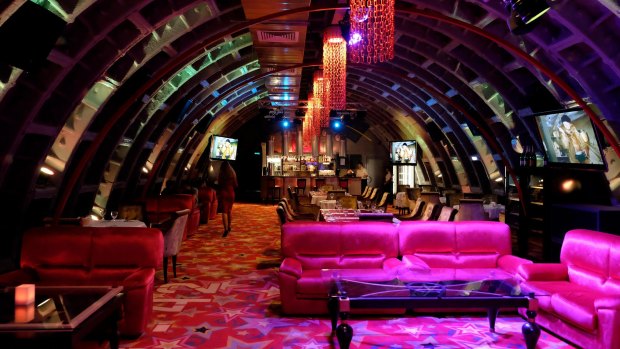
An underground tunnel leading to a restaurant located inside the Tagansky Protected Command Point, also known as bunker-42 a once-secret military complex.Credit: Alamy
It's for that reason I've decided to return 35 years after my first visit. Back then it was an amazing place, but with an outlook darkened by shortages of nearly everything, queues for food and luxury goods, and an economy on the verge of collapse.
Yet it was still an intriguing nation, with a dramatic history lurching from the staggering wealth of the tsars to the Bolshevik revolution that changed the world, to rampant capitalism and now the staggering wealth of the oligarchs and Putin, with an estimated $200 billion fortune.
Along its colourful way, it became a showcase of some of the most lavish palaces on the globe, many of the most stunning cathedrals, 23 UNESCO World Heritage sites, incredible collections of artworks, a vibrant dance and culture scene, and a kaleidoscope of ethnicities and beliefs.
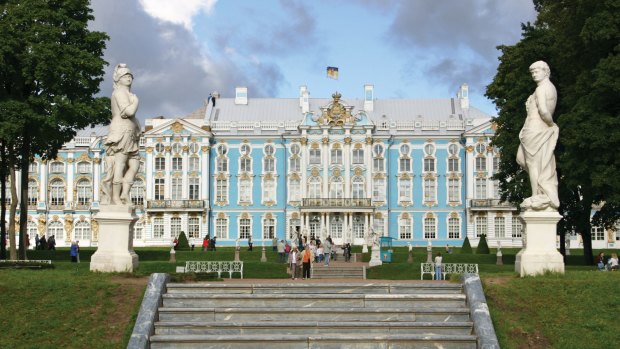
Catherine's Palace.
I've taken a 14-day APT cruise from Moscow to St Petersburg, travelling along seven rivers, including Europe's longest, the Volga, three lakes, two reservoirs, 10 locks and two canals, visiting the so-called "Golden Circle" of sights in between.
The whole journey is, this time, a most pleasant surprise. Although it's a country continually in the news for allegations of spying activities, political interference and autocratic leadership, it's a revelation of friendliness and simple courtesies. It's only the officials who are paid to be helpful, who really aren't, someone comments.
Russia's economy is also unexpectedly buoyant and, in the week I arrive, it, together with those of the other former states of the USSR, are named as making up the strongest-performing world region in the year to date in terms of residential price growth, by the annual Knight Frank index.
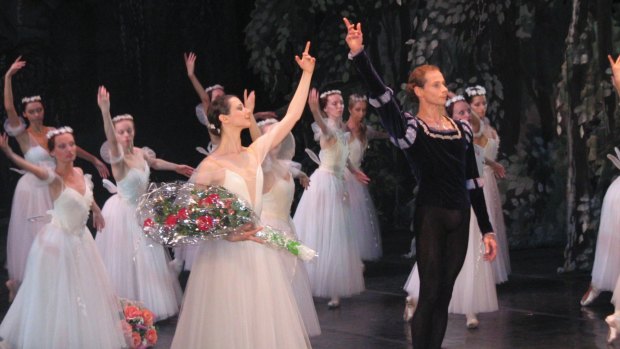
Ballet performance at the Hermitage.
"I think overseas we're still often presented as the Dark Evil Empire," says the same guide. "But that's simply not true. We are a very different country today than the one we perhaps used to be.
"And don't just take Mr Putin's word for it …"
THE GILDED CAPITAL AWAITS
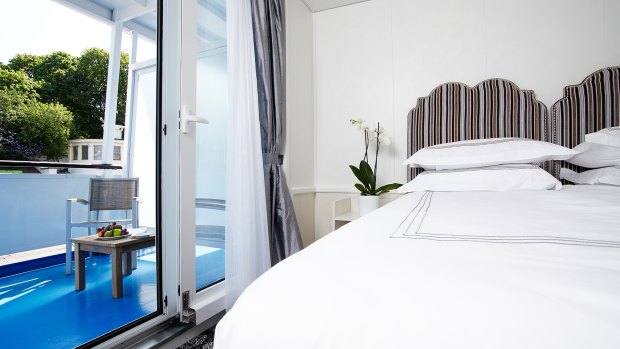
A baloncy cabin on MS Valentina. Credit: APT
This is a shock: there are thousands of soldiers and police out on the streets of Moscow the day we arrive. There's also the rumble of tanks, the screeching of planes overhead and barricades manned by armed police sealing off many of the streets.
Another revolution? A counter-revolution? A response to a tweet by the US President? Ah, no, it's Victory Day, the annual parade to mark the end of World War II and Russia's triumph.
Being there in Red Square where it's all centred would have been a great introduction to Russia, its military might and Mr Putin's vision for the country – something Mr Trump seemingly would like to emulate – but there's no way in for anyone who's not marching, or is a member of the government, or of someone else's.
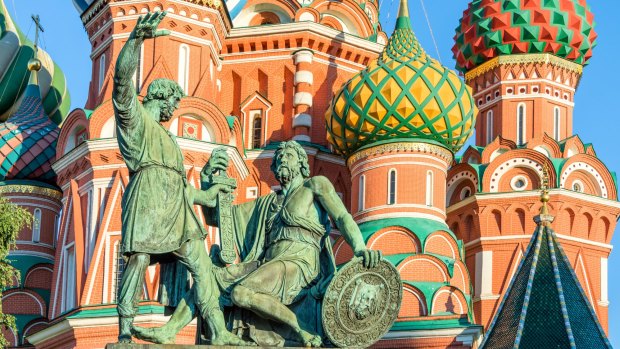
Moscow's Red Square with one of its many monuments and St Basil's Cathedral.Credit: iStock
But watching everyone troop past with their band instruments, seeing people line the streets with their flags, medals and army caps, and experiencing that air of jubilation for the war victory, or perhaps simply for the public holiday, sets the mood nicely.
The morning after, Red Square has only a few stragglers left, but it's still impressive. This is what we always picture when we think of Russia: that vast square that's been the site of so much history, the colourful confection of St Basil's Cathedral sitting below the ramparts of the Kremlin, the magnificent Cathedral of Christ the Redeemer and the monument to Peter the Great.
I drink coffee in one of the new cafes now around the square and ponder how the buildings are just the same as when I was last here in, ironically, 1984, but how much everything else has changed.
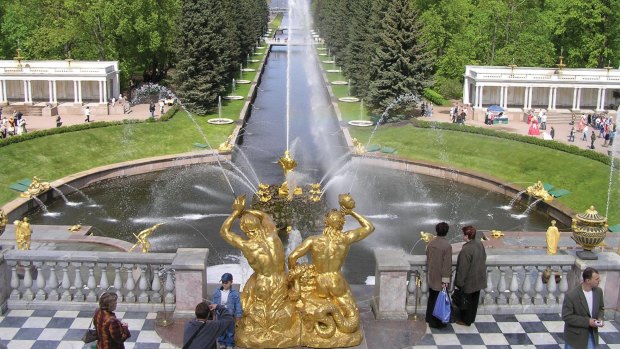
Peterhof Place in St Petersburg.
Back then, travelling from Africa to Europe via the much-maligned Soviet airline Aeroflot – on which you could happily sleep curled up on the floor of the plane without any interference from stewards – I'd stopped off for a few days in Moscow. But in those days, Europe's largest city by both area and population felt like a grey, grim place with anyone not in army uniform dressed in shabby black or brown clothes, looking cold and miserable and hungry, and seeming terribly unfriendly to visitors.
Now it's a different world: a bright, busy, modern metropolis (albeit with 11th-century origins and plenty of buildings remaining from the 16th and 17th centuries), teeming with fashionably dressed locals, shopping at global brand stores, and smiling. Share bicycles and scooters line up on main streets, there's the most expensive stadium ever built for 2018's World Cup and new signposts in both Cyrillic script and English for the benefit of visiting football fans.
Of course, the main attractions remain, although they are displayed in a much more accessible way, and often with information in English. The Kremlin fortress in the middle of the city, for instance, that's now Mr Putin's office, is a huge building, and its armoury, set up in 1508, is still a fabulous museum, housing the crown jewels of the empire.
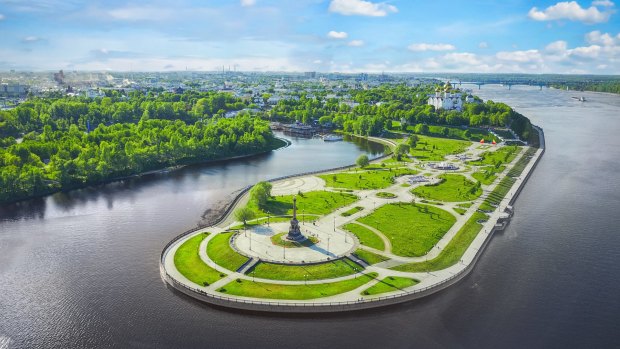
Famous Strelka park in place of confluence of Kotorosl and Volga rivers in Yaroslavl, Russia.Credit: iStock
There are weapons, paintings, Ivan the Terrible's ivory throne and bear-fur-lined coat, Catherine the Great's carriages, embroidery studded with pearls, the magnificent silver gowns of the last of the ill-fated Romanovs, and a collection of 10 of the most exquisitely ornate, delicately carved, priceless Faberge eggs.
The armoury is usually packed with visitors, but happily APT negotiates an early entry for us cruise passengers, so we're able to follow our tour guide through in uncrowded comfort. So many riches: little wonder the peasants were revolting.
REMEMBER THE COLD WAR?
Have you ever wondered what it might be like to press the big red button to launch a nuclear attack? Eighteen storeys and 65 metres down under the streets of Moscow, we visit Bunker 42, the hidey-hole and Cold War emergency headquarters built in the 1950s for Stalin and the heads of government where they could take refuge and launch their own nuclear strike, and we have the opportunity to press that button ourselves.
It sets off a chain reaction of horror, shown on a screen above, which fortunately never happened. But the atmosphere is atomic. Being escorted by a tour guide dressed in KGB uniform who barks instructions only adds to the atmosphere.
Part of the 7000-square-metre maze of tunnels and rooms has now been converted to a restaurant where we have lunch, to the songs of a military choir who sing with such passion and gusto, everyone in the room is moved. I love it.
Happily, we don't have to walk back up all those 18 floors of stairs. There's a lift and just nearby there's the escalator to the underground train system, the Moscow Metro, that Stalin had built.
Perhaps understandably in modern Russia, there's not so much nostalgia about the old days of the Soviet Union. There are few T-shirts, mugs or posters of Lenin, Marx or Stalin around; they all seem to have been replaced by souvenirs emblazoned with a bare-chested Putin riding on the back of a bear, or commanding tanks.
He has plenty of rivals in his self-aggrandisement though. Moscow is stacked with monuments to seemingly almost every figure who's ever featured in its past, people's heroes and the huge numbers of war dead, in between the old bridges over the river and the golden onion-shaped domes of the Russian orthodox churches that survived Stalin's reign.
But life is now so much easier for everyone, with 85 per cent of property privately owned. It was once unthinkable to buy your apartment or even live in it without sharing with other families. It's also now possible to make jokes about leaders without fear of reprisals.
On the other hand, there are now big divisions between rich and poor, and some miss the equality that was the hallmark of the old regime, the free education and medical care. "Life is better now," says one Russian, "but we lived better in those times."
SHIP-SHAPE LIFE ON BOARD
Cabins on our Russian-made ship, the MS Valentina, are small but functional and comfortable, and our mooring on the river allows us to sit on the balcony and watch Muscovites rush around their daily routines.
The food is surprisingly good too.. Lunch is usually a buffet with soup, hot meats, cold cuts, vegetables, salads and both European and Russian specialty dishes, and a ruinous range of desserts, cakes and cheeses. Dinners tend to be sit-down meals, with a menu and more choice. A special Ukrainian degustation one evening, followed a couple of days later by a Russian degustation, are real treats.
They're served up by a phalanx of uni students working here over their summer break. Apparently, it is easier to teach English-speaking students hospitality skills, than teaching wait staff English – who, as soon as they'd become proficient, quit for better-paid jobs.
Evenings are spent in the lounge, with daily briefings about the next day's activities, entertainment by musicians, dancing, a singer and one of the tour guides doubling as a quiz master.
There are also Russian history lectures which, thanks to one of the best guides I've ever encountered, Misha Smetnick, are utterly absorbing. There's also Russian language lessons, talks on which Russian souvenirs to buy, a Russian dance tutorial, a class in blini-making, and Dr Zhivago on the in-room TV.
DASTARDLY DEEDS, DEATH AND DANCING
Poor Dmitry, the youngest son of Ivan the Terrible, was exiled to the town of Uglich on the banks of the Volga and then died in mysterious circumstances. Some say he stabbed himself several times with a knife while having an epileptic fit. It's perhaps a little more likely that he was assassinated by a rival to the throne.
Today, when we arrive, Uglich is looking a little like butter wouldn't melt in her mouth which is possibly true since it's a place well known in Russia for the quality of its milk, cheese and ice-cream.
It's a pretty little town with lots of beautiful old architecture. One of its churches, built in 1628, is considered a true gem of Russian medieval architecture and it becomes magical when a choir unexpectedly file in and their voices soar through the hall.
Yet Stalin's presence can also be felt. The bell tower was where his parachute jumpers practised, landing unharmed into the water. In line with his disapproval of religion, he used the cathedral to store tractors.
Our next stop is the oldest of the towns on the Volga, Yaroslavl, which traces its roots back to the Vikings. Along with the handsome churches and monastery, is a statue of Lenin pointing in the middle of its Red Square. This is another UNESCO World Heritage Site.
At the monastery, there's a concert of bell ringing, with 15 bells operated via a labyrinth of strings out in the open. A tour of the local Governor's House, conducted by his daughter dressed in an 18th-century A-line gown turns into something quite delightful when a string quartet strikes up in the ballroom, and a group of young people in similar period costume file in to dance – and then invite us to join in too. We do our pathetic best.
THE VODKA SURVIVAL STRATEGY
Why is vodka so important to Russians? Well, if we ever had to cope with winters that last nine months of the year, temperatures that dip to minus-15 degrees, thick snow and the river frozen solid, we'd probably be equally enthusiastic about it as a way to keep warm.
"Russian weather is nine months of expectation," says guide Misha Smetnick, "and three months of disappointment."
The weather can be an ally at times, however. Visiting the 14th-century Kirillov Monastery in the town of Goritsy – where Ivan the Terrible had his own cloister – we're told that Polish troops once laid siege to it for six years in the 17th century, but were driven back by the cold and could never occupy it.
Back on the ship that evening, there's a vodka-tasting of three generous shots of different varieties, accompanied by snacks. One tastes of chilli and honey, one of fruit and the third of, well, pure alcohol. We're taught to look at it, smell it, inhale its aromas to prepare the palate and then drink it in one fiery gulp. Tonight, everyone sleeps soundly.
Happily, it's summer now that we're just a couple of degrees south of the Arctic Circle, where an island in the centre of Lake Onega, Kizhi, has become an open air museum of 87 historic wooden buildings, moved there in the hope of preserving them.
Among the bell towers and chapels, there's a windmill and the astonishingly elaborate Transfiguration Church, built in 1714 without a single nail, which is another of Russia's most recognisable sights. There are also peasant homes to visit, where families lived in small rooms, often sleeping just by the stove to keep warm, and having their animals close by in the same house to keep them alive during the bitter winters.
The vodka museum, with 3500 different bottles and generous tastings, is the star of our last cruising stop, Mandrogi, a town destroyed in World War II. It was bought by investors who invited people with traditional skills to settle there and practise their crafts, including great woodworkers, jewellery-makers and dressmakers.
Warmed by that vodka, lunch is outdoors and a Russian version of a barbie – dishes of skewered meat with vegetables and salads – is served as an incredible balalaika player plays Jimi Hendrix, Vivaldi's Four Seasons and Rimsky-Korsakov's Flight of the Bumblebee on his three strings. Unbelievable.
THE VENICE OF EASTERN EUROPE
Our final stop is Russia's second-largest city, St Petersburg. The former capital of imperial Russia is a grand jumble of winding canals, little stone bridges and incredible palaces.
The Peterhof Palace is the Russian equivalent of France's Versailles, with magnificent halls and painted ceilings, glittering chandeliers, beautiful artworks, and imposing gardens.
And, of course, there's the Hermitage, the second-largest art museum in the world, after the Louvre in Paris. Founded by Catherine the Great in 1764 as part of the Winter Palace, it's simply dazzling, with more than 1000 rooms and a collection of more than 3 million items, including works by Rembrandt, Rubens, Raphael and Titian.
It's estimated that, if a visitor were to spend one minute in front of every exhibit, it would take them six years to see everything on display. Again, just as with the armoury at Moscow's Kremlin, APT has organised to get us in early before the crowds, so we have a privileged tour of many of the rooms. It is quite overwhelming.
We follow up with visits to St Isaac's Cathedral, the Fortress of St Peter and St Paul, and the Church of our Saviour on the Spilled Blood where Tsar Alexander II was mortally wounded in a third assassination attempt.
Maybe it's the result of such a tumultuous history or all that vodka, but they certainly breed these Russians tough.
FIVE ETIQUETTE TIPS FOR VISITORS TO RUSSIA
1.Don't be put off by stern faces. In Russia, formal behaviour is a way of showing others respect.
2.Be prepared to be asked very direct questions. Russians can be quite curious and forthright, and don't see that as being rude.
3.If invited to someone's home, it's polite to dress smartly and bring a small gift for the host.
4.When you ask someone how they are, don't be concerned if they say they're just OK. Saying they're good can be seen as boastful.
5.Don't assume all Russians are happy with the fall of communism; some are still struggling to adapt to the momentous changes to their lives.
FIVE DISHES EVERYONE SHOULD TRY
1.BORSCHT
A hearty beetroot soup, traditionally made from meat stock and sautéed vegetables. Tastes delicious, but try not to spill any on clothes. It's impossible to get the stains out.
2.BEEF STROGANOFF
A traditional Russian dish – who knew that? – which is found everywhere in the country. It's seared beef in a thick sour-cream gravy made with beef broth, mushrooms and mustard.
3.BLINI
Small Russian-style pancakes, most usually served with smoked salmon, sour cream, dill and caviar, but can be served with almost any toppings.
4.MIMOSA
A cold salad of cheese, eggs, canned tuna, onion and mayonnaise. Surprisingly nice.
5.POTATO CAKES
A dessert that tastes nothing like potato because, as I later found out, they're only named that as they're small round balls that bear a passing resemblance to potatoes. They're actually made of cake, fruit, nuts, liqueur and cocoa powder.
TRIP NOTES
Sue Williams travelled courtesy of APT.
MORE
FLY
Several airlines fly from Australia to Moscow, with one stop along the way, including Qatar Airways, Emirates and Etihad.
CRUISE
The MS Valentina is one of the 196-passenger river ships APT charters for its voyages. See aptouring.com.au
STAY
APT uses the Hotel Kempinski Baltschug Moscow and the Hotel Kempinski Moika 22 in St Petersburg.
Sign up for the Traveller Deals newsletter
Get exclusive travel deals delivered straight to your inbox. Sign up now.